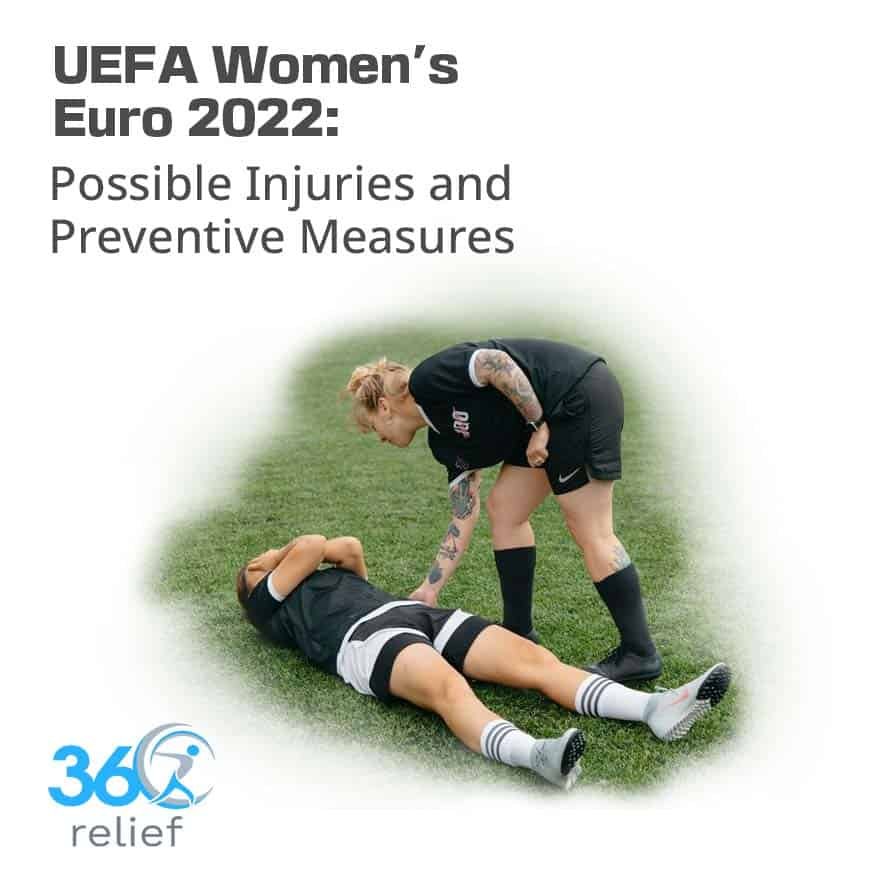
Flat 10% Off This Black Friday: Shop Smart, Save Big on Compression Socks and Other Support Braces
This Black Friday, take advantage of exclusive 10% savings on some of 360 Relief’s best-selling compression socks and support braces!

Table of Contents
ToggleThe Union of European Football Association, UEFA Women’s Euro is a football tournament held between national teams of the UEFA confederation. The association was established in 1982, and the first tournament was played in 1984, which was won by Sweden. Initially, the tournament was played as a four-team tournament. In 1997, the 7th edition of the tournament comprised eight teams. The third expansion happened in 2009 when a total of 12 teams played in the tournament. However, from 2017 onward, 16 teams are participating in the UEFA Women’s Euro championship. From its beginning, 12 tournaments have been played, and Germany won 08 matches, securing its position as the most successful team in the UEFA.
England hosts the 13th edition of the EUFA Women’s Euro. Before this, England also hosted the 9th edition of the tournament played in 2005. The UEFA Women’s Euro 2022 is going to be started on July 6th, 2022, and will last until July 31st, 2022. As football is one of the high-contact sports, it may cause several injuries, including lower and upper extremity injuries. According to the British Medical Journal, 12 studies were published between 1991 and 2018, showing the incidence of injury in adult elite women’s football. These studies have shown the results of the domestic club football injuries and injuries found in tournaments.
In domestic club football, the total injury rate was estimated to be 5.7/ 1000 hours of playing. It includes 3.1/100 hours of training and 19.5/1000 hours of matches. Football match incidents in tournaments were estimated to be 55.7/1000 hours of playing. The following are the common injuries with their incident rates in percentages:
| No. | Injuries | Incident Rate |
| 01. | Knee injuries | 22.8% |
| 02. | Ankle injuries | 23.7% |
| 03. | Ligament sprains | 27.8% |
| 04. | Muscle strain | 19.1% |
Watching the football tournament encourages football lovers to get out and play after seeing their favourite players in the tournament. But playing football requires several actions to perform. For example, whether playing occasionally or participating in a tournament, a football player requires side-to-side movements, running, jumping, and pivoting. All these actions can cause several injuries to your body. We have done fine research on the ideas of the possible injuries that occur during footballs. All the possible injuries resulting from football are discussed here. As well as this, the possible preventive measures suggested by experts are also mentioned, helping you get a safe football experience.
The following are the common football injuries:
Rotator cuff injury occurs due to a tear in any of the shoulder muscles or tendons that stabilise your shoulder joint, helping you lift and rotate your arms. Rotator cuff injury occurs among footballers when they fall onto the ground. Falling on an outstretched arm or collisions can tear the tendons. As well as this, repetitively overhead movements can also cause tendons to tear. Wearing shoulder support braces helps ease the pain and other symptoms resulting from the rotator cuff injuries.
A sprained ankle is an injury resulting from rolling, twisting, and awkwardly turning your ankles. These awkward movements can tear or stretch the ligaments – tough bands of tissues helping hold your ankle bones together. Football players are continuously involved in running, jumping, and side-to-side movements, so these strenuous actions can cause ankle ligaments to tear. As well as this, falling directly on the ground can also cause ligaments to damage. Experts suggest wearing ankle support braces to minimise pain and other discomforts after an ankle injury.

Patellar tendinitis, commonly known as Jumper’s knee, is a condition that results in inflammation of patellar tendons. The patellar tendon connects the knee patella to your tibia (shinbone). Remember that Jumper’s knee weakens your tendons; however, when left untreated, it can lead to a tear in the tendons. The Jumper’s knee is usually caused by overuse and the repetitive movements of your joints. For example, frequent jumping on the hard surface is a leading factor contributing to the Jumper’s knee development. Footballers involved in continuous jumping and other strenuous activities are at a high risk of Jumper’s knee. Experts suggest wearing knee support braces to help manage knee problems.

An overuse injury to the Achilles’ tendons is referred to as Achilles tendinitis. Achilles tendons are the band of tissues that attaches the calf muscles to your heel bones at the back of the lower leg. Achilles tendinitis is common among people involved in running and suddenly increases the duration or the intensity of their running. Footballers usually involve abrupt movements and repetitive actions that cause Achilles tendons to be injured, leading to Achilles tendinitis. The injury to the Achilles tendons can happen suddenly or little by little. Healthcare professionals suggest wearing the best foot support braces to help manage the symptoms of Achilles tendinitis.
Shin splint is a condition that causes pain and tenderness in the lower legs. They may result from strenuous exercises and high-contact sports requiring repetitive movements of the legs. Sin splint causes pain and other discomforts on the front or outside the shin as well as inside the lower leg just above the ankles. Footballers having weak calf muscles and wearing improper or wrong footwear are at a high risk of calf or leg injuries, such as shin splints. Healthcare advisors or professional trainers suggest wearing calf supports or sleeves to help minimise the symptoms of shin splints.

Whether you are a professional footballer or participate occasionally, you should follow the given preventive measures that will surely help you get an injury-free football experience:
Lack of body warm-up is one of the leading causes causing injuries during sports, including football. Whether you are an amateur player or participate in the tournament, you need to warm up your body before every session. As well as this, ensure that your body is cooled once the session is over. This will help you prevent injuries during or after playing sports.
All sports, including football, require the use of core muscles. So, it is necessary to strengthen those muscles to improve your athletic performance. You can take help from your professional trainers to strengthen and maintain your weak core.
Regular stretching or strengthening exercises help keep your muscles and joints active and flexible. This will surely enhance your athletic performance and gives you an injury-free sports experience.
Being hydrated adequately helps you maintain your overall health or fitness and minimise the risk of cramps. As well as this, maintain your diet to keep yourself fit physically as well as mentally.
Wearing protective equipment ensures the best performance. As well as this, it also helps avoid the chances of overuse injuries. You should wear protective equipment whenever you are susceptible to injury during practice or a tournament.
Football is one of the most thrilling or exciting sports in the world. Every year football events or tournaments are organised from across the world. The UEFA Women’s Euro 2022 is on the head. Football enthusiasts eager to play football are advised to follow all the preventive measures mentioned above, helping them achieve a wonderful or injury-free sports experience.

This Black Friday, take advantage of exclusive 10% savings on some of 360 Relief’s best-selling compression socks and support braces!

Everyday life includes walking up stairs, but knee discomfort can make this basic activity difficult. Walking up or down stairs

Cooking is a beloved activity for many, but for those struggling with knee pain, standing in the kitchen can quickly

We’ve all been there. On a ride in a car, for instance, to the country home for a weekend break

Gardening is enjoyable for many people and those who like tending to their lawns and plants usually find it therapeutic

Do you have a painful knee problem that takes you to physiotherapy…for an injury that hampers your daily living…your workout

Training can be very much associated with some pains and injuries that may be experienced by the trainers. As there

Office workers often spend hours seated at their desks, focusing on tasks while unknowingly putting their health at risk. The

Winter often brings more than just a change in weather; for many, it also means dealing with unexpected swelling in

Compression socks have become a critical tool for athletes across all sports. Whether you’re a marathon runner, cyclist, or weightlifter,

October marks the beginning of National Cholesterol Month in the UK, a time dedicated to raising awareness about cholesterol and

Overall, there is nothing to match the experience of watching musicians perform live in an outdoor concert in Glastonbury. However,

Today charity runs have gained popularity as a way of raising cash for a cause in the United Kingdom. From

Top 360 Relief Items for a Pain-Free Olympic Experience in Paris 2024 The Olympic Games are the most unique sporting

Wimbledon 2024 of tennis takes place annually at the prestigious All England Club and aims to provide tennis lovers with
Please enter your email to subscribe to our newsletter for exclusive offers and updates
Copyright © 2024 | 360 Relief Ltd | Sitemap

